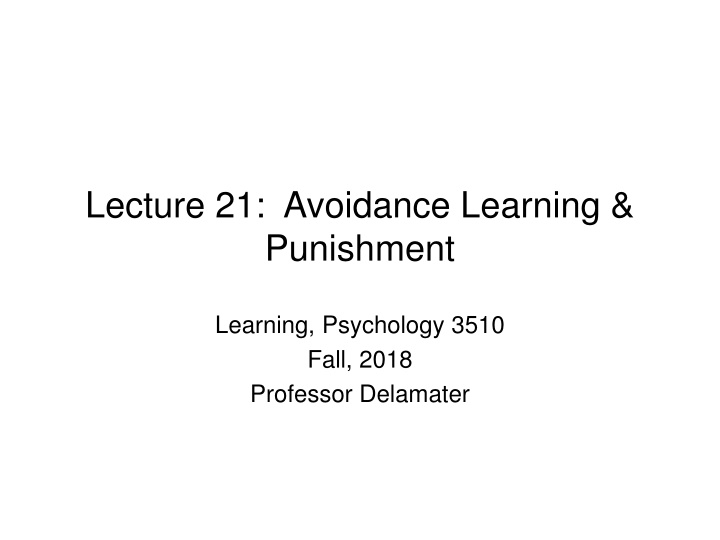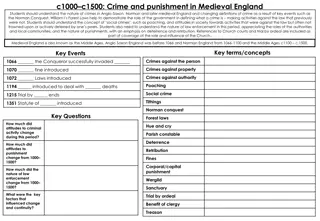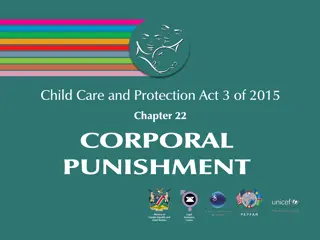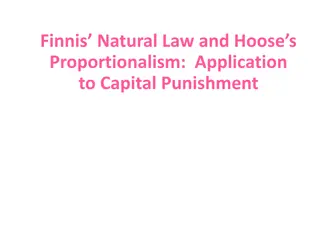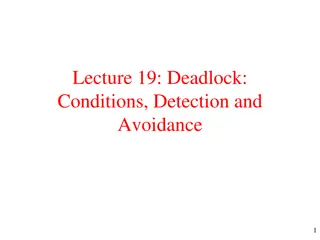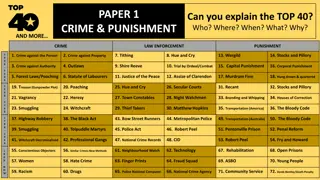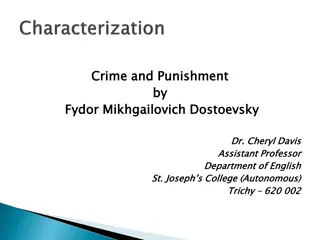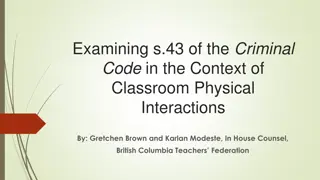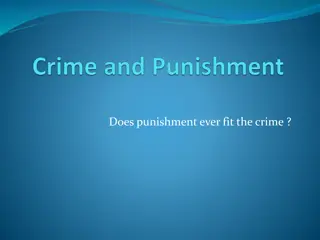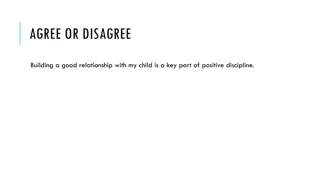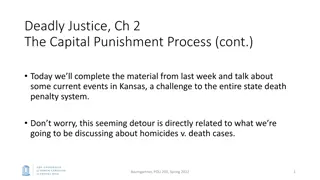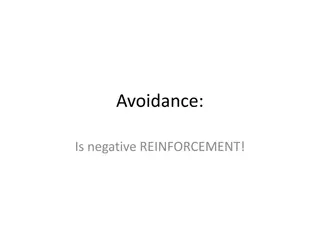Lecture 21: Avoidance Learning & Punishment
Delve into the complexities of avoidance learning and punishment in the realm of psychology with Professor Delamater's enlightening lectures from the fall semester of 2018. Gain a deeper understanding of these crucial concepts, their impact, and applications in various psychological frameworks. Explore the intricacies of human behavior through the lens of avoidance learning and punishment, and unlock valuable insights that can shape your understanding of cognitive processes and decision-making.
Uploaded on Mar 05, 2025 | 3 Views
Download Presentation

Please find below an Image/Link to download the presentation.
The content on the website is provided AS IS for your information and personal use only. It may not be sold, licensed, or shared on other websites without obtaining consent from the author.If you encounter any issues during the download, it is possible that the publisher has removed the file from their server.
You are allowed to download the files provided on this website for personal or commercial use, subject to the condition that they are used lawfully. All files are the property of their respective owners.
The content on the website is provided AS IS for your information and personal use only. It may not be sold, licensed, or shared on other websites without obtaining consent from the author.
E N D
Presentation Transcript
Lecture 21: Avoidance Learning & Punishment Learning, Psychology 3510 Fall, 2018 Professor Delamater
4 Basic Instrumental Contingencies Recall that there are 4 basic types of instrumental contingencies. We ve focused on positive reinforcement, but now lets talk about negative reinforcement and punishment. Once again, the 4 contingencies refer to when the Response leads to Positive Event (Positive Reinforcement) Response leads to Negative Event (Punishment) Response leads to termination or prevention of Negative Event (Negative Reinf) Response leads to termination or prevention of a Positive Event (Omission) Reinforcement procedures increase responding, the others decrease responding.
Avoidance Learning: 2 Tasks 1. Signaled Avoidance learning task (shuttle box avoidance) occurs in the presence of a warning stimulus. Rats learn to escape foot shock by shuttling from one side to the other once shock presence of the warning stimulus prior to the scheduled shock delivery. They also learn to avoid foot shock by shuttling from one side to the other in the
Avoidance Learning: 2 Tasks 2. Unsignaled Avoidance learning task (Sidman avoidance) the avoidance response. This is called the shock-shock interval (S-S). If they make the target response (e.g., lever press, shuttle jump, wheel run, etc), this will Delay the next shock for some time. This is called the response-shock interval (R-S). Better avoidance learning occurs with short S-S and long R-S intervals. The animals use the passage of time as a discriminative cue (a warning stimulus) for when responding will be effective. In this case rats will get a foot shock within a specific time interval if they do not make
Avoidance Learning: 2 Tasks 2. Unsignaled Avoidance learning task (Sidman avoidance) Sidman (1966) related to the length of the response-shock (R-S) interval. Responding on this schedule increases over time since the last response, and is
Avoidance Learning: Theoretical Approaches The basic quandary: How does the non- occurrence of an event reinforce behavior??? After all, a successfully avoiding animal makes a response and nothing happens. Why should that continue to reinforce behavior? This problem plagued behaviorists who did not wish to admit that internal, non-observable, psychological processes figured into a theory of behavior. So, from this perspective it is not easy to see why the non-occurrence of something should have such a strong effect on behavior.
Avoidance Learning: Theoretical Approaches 1. Two-Process theory Pavlovian Process (warning stimulus associates with shock US, and produces a fear CR) Instrumental Process (termination of the warning stimulus and the fear CR negatively reinforces the response) Evidence: Escape from Fear studies (EFF)
Avoidance Learning: Theoretical Approaches 1. Two-Process theory Pavlovian Process (warning stimulus associates with shock US, and produces a fear CR) Instrumental Process (termination of the warning stimulus and the fear CR negatively reinforces the response) Evidence: Escape from Fear studies (EFF) simultaneous conditioning, and the third gets CS and US Unpaired (this is the control group). Then all groups are trained in a shuttle avoidance task, but no shocks are presented. Instead, the CS is presented and shuttle avoidance responses turn off the CS. The Delayed and Simultaneous pairings groups both show decreased shuttle avoidance latencies over trials, whereas the unpaired group does not. This indicates that the response is negatively reinforced simply as a function of turning off the aversive CS. This lends support for two-process assumptions. In this study, Pavlovian fear conditioning occurs first. One group gets Delayed conditioning, another gets
Avoidance Learning: Theoretical Approaches 1. Two-Process theory Pavlovian Process (warning stimulus associates with shock US, and produces a fear CR) Instrumental Process (termination of the warning stimulus and the fear CR negatively reinforces the response) Evidence: Escape from Fear studies (EFF) Problem: While the warning stimulus evokes a fear CR early in training, this fear CR goes away with extended training even though the avoidance response does not. One stimulus, A+, signals avoidance. A second, B+, is a Pavlovian CS. A third, C-, is not paired with shock. Humans could avoid finger shock (mild) by pressing a key in the presence of A. Skin conductance responses are a measure of fear CRs, and these go down to A, but increase On B+ trials over training. Shock expectancies increase to B, but decrease to A. This study shows that avoidance responding persists even when fear to A does not. Lovibond, et al (2008) study
Avoidance Learning: Theoretical Approaches 1. Two-Process theory 2. Safety-signal Hypothesis Safety signals are response-produced cues that signal the absence of shock. They, in essence, become conditioned inhibitors of fear. And, they positively reinforce the response that leads to them. Evidence: Presenting an explicit stimulus following each avoidance response results in that stimulus becoming a conditioned inhibitor of fear. These explicit stimuli also speed up the rate of avoidance learning.
Avoidance Learning: Theoretical Approaches 1. Two-Process theory 2. Safety-signal Hypothesis Safety signals are response-produced cues that signal the absence of shock. They, in essence, become conditioned inhibitors of fear. And, they positively reinforce the response that leads to them. Evidence: Presenting an explicit stimulus following each avoidance response results in that stimulus becoming a conditioned inhibitor of fear. These explicit stimuli also speed up the rate of avoidance learning. 3. SSDR theory and concept of predatory imminence (remember behavior systems theory) Some responses are easier to learn than others (e.g., running vs rearing) This is because some responses are innate species specific defense reactions Which behavior occurs depends on how far away from the threat the animal is at any moment. This will partly determine the type of avoidance responses seen. E.g., rats and snakes . Seek dark place Freezing explosive leaping
Avoidance Learning: Theoretical Approaches 1. Two-Process theory 2. Safety-signal Hypothesis 3. SSDR theory and concept of predatory imminence 4. Expectancy theory Animals acquire R No Shock and No R Shock associations (expectations) These determine avoidance responding, as a rational decision making process. Explains why avoidance responding is difficult to extinguish.
Avoidance Learning: Theoretical Approaches 1. Two-Process theory 2. Safety-signal Hypothesis 3. SSDR theory and concept of predatory imminence 4. Expectancy theory Animals acquire R No Shock and No R Shock associations (expectations) These determine avoidance responding, as a rational decision making process. Explains why avoidance responding is difficult to extinguish. Interesting experiment: Learned Helplessness Effect Animals in the yoked inescapable shock group later learn to avoid poorly. Is this due to learned helplessness (an expectation that responding has no effect)?
Avoidance Learning: Theoretical Approaches 1. Two-Process theory 2. Safety-signal Hypothesis 3. SSDR theory and concept of predatory imminence 4. Expectancy theory Animals acquire R No Shock and No R Shock associations (expectations) These determine avoidance responding, as a rational decision making process. Explains why avoidance responding is difficult to extinguish. Interesting experiment: Learned Helplessness Effect Animals in the yoked inescapable shock group later learn to avoid poorly. Is this due to learned helplessness (an expectation that responding has no effect)? But explicit backward cues following shock alleviate the harmful effects of inescapable shocks. That result supports the view that safety signals play a role (Jackson & Minor, 1988, chap 5).
Punishment: Important Factors 1. Shock intensity & gradual increases in severity 2. Response contingency (contingent more effective than non-contingent shocks) 3. Delay of punishment (increasing delay reduces its effectiveness) 4. Schedules of punishment 5. Schedules of positive reinforcement (stronger reward contingencies hard to punish) 6. Availability of alternative reinforced responses 7. Effects of discriminative stimuli (learning when punishment can occur) 8. Punishment as a signal for availability of positive reinforcement (e.g., attention) Azrin, Holz, & Hake, 1963 Pelloux, Everitt, & Dickinson, 2007 Even a small amount of contingent punishment (FR 1000) can reduce appetitive responding Extended cocaine self-admin results in Resistance to punishment in some animals
Punishment: Theoretical Approaches 1. Conditioned emotional response theory (Cues associated with punishment elicit a competing fear CR) 2. Avoidance theory (other competing behaviors are negatively reinforced) 3. Thorndike s negative law of effect (punishment weakens the S-R association) 4. Expectancy theory (response associates with the punishing event)
